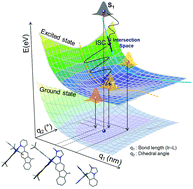A series of Ir(III) complexes (fac-Ir(py), fac-Ir(pz), fac-/mer-Ir(im), and fac-/mer-Ir(bzim)) with 9,9-dimethylfluorenyl (dmf)-based ligands (dmfC^N or dmfC^C:) tuned with various heterocyclic chelating moieties (pyridyl (py), pyrazolyl (pz), imidazolyl (im), and benzimidazolyl (bzim)) were prepared and investigated for the development of novel efficient blue phosphorescent dopants. Of these Ir(III) complexes, the mer-Ir(im) complex was compared with the previously reported Ir(III) complexes, i.e., mer-tris(N-phenyl-N′-methylimidazole)iridium (mer-Ir(pim)), mer-tris(N-dibenzofuranylphenyl-N′-methylimidazole)iridium (mer-Ir(im-O)), and mer-tris(N-dibenzothiophenyl-N′-methylimidazole)iridium (mer-Ir(im-S)), and the effect of replacing the phenyl group of the phenylimidazole ligand with a dmf moiety was also investigated. The steady-state photophysical analysis confirmed that the observed emission colors were tunable from λem = 545 nm (fac-Ir(py)) to λem = 462 nm (fac-Ir(bzim)) depending on the heterocycle type. In addition, lower absorption and emission energies were observed when the phenyl moiety was extended to the dmf analogues of the phenylimidazole ligand. From DFT/TD-DFT calculations and electrochemical analysis, we found that the relative degree of MLCT contribution in the 3MLCT/3LC admixture-based emission process and the structural distortion (ΔQe) between the excited and ground states affect the quantum efficiencies and radiative rate constants of the Ir(III) complexes, which is related to the electroluminescence performance. The mer-Ir(im) and fac-/mer-Ir(bzim) with high emission quantum yields of ≥85% in the film state were evaluated as dopant materials in blue PhOLEDs. The mer-Ir(im)- or fac-/mer-Ir(bzim)-doped devices exhibited external quantum efficiencies of 17.3%, 14.2%, and 11.9% with CIE coordinates of (0.21, 0.41), (0.18, 0.33), and (0.19, 0.36), respectively.
